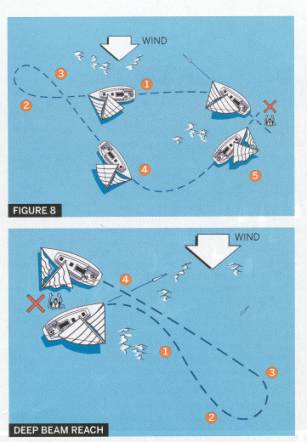|
Overboard
and Back
Sail Magazine Dec 2005, pg 35
http://www.sailmagazine.com
 Although
we have taught the traditional Figure 8 return pattern to beginning students for
21 years, the results of our fourth national Crew Overboard tests have convinced
us to change to the simpler Deep Beam Reach method. The high winds on San
Francisco Bay make any crew-overboard maneuver difficult, and there is no point
in teaching an unnecessarily complicated return. Here is the comparison. Although
we have taught the traditional Figure 8 return pattern to beginning students for
21 years, the results of our fourth national Crew Overboard tests have convinced
us to change to the simpler Deep Beam Reach method. The high winds on San
Francisco Bay make any crew-overboard maneuver difficult, and there is no point
in teaching an unnecessarily complicated return. Here is the comparison.
FIGURE 8
Come onto a beam reach (1); sail 3 to 4 boat lengths away from the MOB (2); tack
(3); come onto a broad reach (4); on the final approach, turn up to a close
reach (5).
DEEP BEAM REACH
Sail 10 to 20 degrees below a beam reach (1); sail 3 to 4 boat lengths away (2);
tack (3); point the boat at the victim, approaching on a close reach (4).
The advantages of the Deep Beam Reach are:
• Simplicity—two points of sail versus three points of sail.
• Speed—the boat returns to the victim in a little less time.
• Accuracy—after the tack the helmsman can orient by the simple act of
pointing the boat at the victim.
• Ease—the Deep Beam Reach is easier to master. In all cases, you should
alert the crew (yell "Overboard"), throw flotation, and appoint a
spotter to keep an eye on the person in the water. Also, slow the boat on the
final close-reach approach by luffing the sails. With practice, the distance the
boat sails away on the Deep Beam Reach can be as little as two boat lengths.
Tradition is powerful, and the Figure 8 method has many adherents. Nevertheless,
safety demands the best possible MOB recovery method. Rational analysis combined
with extensive practical experience indicates that the best overall method for
beginning students is the Deep Beam Reach. For more on these recovery methods,
log on to www.sailmagazine.com
LEEWARD VS. WINDWARD PICKUP
On the question of whether to pick up the MOB on the leeward or the windward
side of the boat, the jury is in: The leeward side wins. We spent a lot of time
on this issue between 1993 and 1996. All seven sailing schools in the Bay Area
were unanimous in choosing to pick up a victim from the leeward side of the
boat.
Sailing instructors from light-wind areas feared that the boat would strike the
person in the water if the boat approached from upwind. We found, instead, that
in 25 knots of wind the failure rate of windward pickups was far higher than for
leeward pickups; as the boat slowed on the final approach, it drifted to leeward
much faster than the victim Then the crew on deck had to start over on a new
approach, wasting precious time. Eventually there was nearly unanimous
preference for a leeward pickup.
A few weeks after the 1996 tests, a group of us went out beyond the Golden Gate
Bridge, into the open ocean, on a Mason 43. There were several experienced
instructors and three wet-suited divers with helmets. We spent an afternoon
doing maneuvers in seas of 5 to 10 feet, and we discovered something unexpected.
As soon as a diver grabbed a throw line and was pulled next to the boat, he rose
and fell in the same harmonic wave pattern as the boat. Hence, there was no tendency
for the boat to come oft a wave and crash into the victim. This strengthened the
argument for a leeward recovery.
A rare exception might be in shallow water, when a relatively light boat
driven fast can become almost airborne coming off a wave. This may be the one
time when a windward pickup is the safest.
APPROACH SPEEDS
During the 1996 tests we ran a series of trials to answer the question, what is
the optimum speed for making contact with a victim? We knew that virtually all
sailing textbooks call for the boat to be completely stopped. In our trials,
however, the failure rate was significantly higher when the boats were stopped,
compared to when the boats were doing 2 to 3 knots. And after each failure,
the boat had to sail away and get back up to speed for a new approach, which
vastly increased the potential danger for the victim.
To explore this issue, we took a 33-foot sailboat weighing about 12,000 pounds
and, at carefully calibrated motoring speeds of 1,2,3,4, and 5 knots, approached
wet-suited victims numerous times. (These test victims were fit, but not
particularly muscular.) We shifted to neutral when the victim grabbed the line.
It turned out that victims had no problems or complaints at 1, 2, or 3 knots. At
4 knots some could not hold on, although a number of the stronger victims had no
problems at 5 knots.
Just watching these victims grab the line was illuminating. There was no violent
jerking of the arm out of its socket. To the contrary, the person in the water
was dragged a little bit, which in turn slowed the boat down.
This is an entirely repeatable experiment. If you doubt this result, which does
indeed conflict with conventional wisdom, try it. At Modern Sailing Academy we
recommend 2 knots as the optimum approach speed. At 2 knots there is a high
probability of making a successful approach.
|